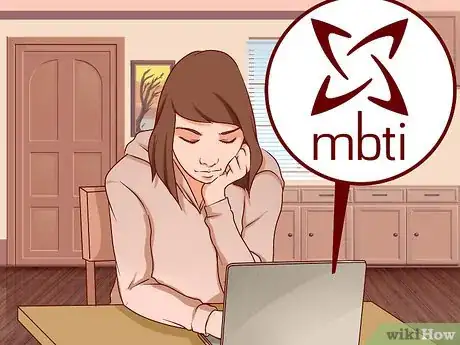This article was co-authored by Moshe Ratson, MFT, PCC. Moshe Ratson is the Executive Director of spiral2grow Marriage & Family Therapy, a coaching and therapy clinic in New York City. Moshe is an International Coach Federation accredited Professional Certified Coach (PCC). He received his MS in Marriage and Family Therapy from Iona College. Moshe is a clinical member of the American Association of Marriage and Family Therapy (AAMFT), and a member of the International Coach Federation (ICF).
There are 23 references cited in this article, which can be found at the bottom of the page.
This article has been viewed 96,558 times.
Shy people are very guarded in social situations. They tend to avoid social interaction and are reluctant to share personal information. This can be frustrating to friends and family who want a deeper connection and potential new friends looking to create a bond.
Steps
Breaking the Ice
-
1Make the first move. Shy people want social interaction, but are often anxious or afraid.[1] Thus, they are not likely to initiate conversation, so be prepared to get the conversation started.
- Approach him casually. A formal introduction may make him nervous and more self-conscious.
- If you are in an unfamiliar place, try approaching him and telling him you're glad to see someone familiar there.
- If you haven't had much contact in the past, explain where you know him from.
-
2Ask a question about the surroundings, request help, or make a general statement about the immediate situation.[2] Focus on thoughts and/or actions, rather than feelings. This will ease him into conversation.
- Ask open-ended questions to prevent him from slipping into a pattern of providing yes or no answers and provide opportunity for follow up questions. It will make keeping the conversation going easier.
- For example, you might ask him, "What project did you come up with for class?" After he answers, you can ask him to explain it to you and ask follow up questions.
Advertisement - Ask open-ended questions to prevent him from slipping into a pattern of providing yes or no answers and provide opportunity for follow up questions. It will make keeping the conversation going easier.
-
3Match his intensity and adopt a similar posture. This will demonstrate your interest without being perceived as aggressive. Mirroring also increases the sense of connection and helps to speed the development of rapport.[3]
- While mirroring involves mimicking behavior, focus more on mimicking his mood and subtle movements. Outright copying may be received negatively.[4]
- For example, if he leans in, you should lean in but don't directly copy every large movement.
-
4Watch his body language. If your guy is really shy, he may not even feel comfortable telling you if he's not comfortable with the conversation. Watch his body language to see if he seems comfortable and relaxed, or nervous and tense.[5] [6]
- If his arms are crossed in front of him or his hands are in his pockets, he probably feels uncomfortable. If his arms are relaxed and hang by his sides, he probably feels pretty chill.
- If his body is angled away from you, it's a sign he'd probably like to get away from the conversation. If his body is angled toward you (including his feet), he's probably interested in staying put.
- If his movements are jerky or tense, he's probably not comfortable. If his movements are fairly smooth and fluid, he's probably feeling all right.
- If he's making consistent eye contact, he's likely interested in continuing the conversation.[7] If his glance darts away or seems unfocused, he's probably feeling uncomfortable.
-
5Transition the conversation to the personal, slowly. The conversation should start superficially and gradually become more personal to allow him to manage his discomfort. Asking questions about what he thinks or feels about the topic of conversation is an easy way to ease into the personal, without becoming too intimate.
- To subtly shift the conversation to the personal, ask "what interested you about the project?" or "why did you choose that project?"
Externalizing his Attention
-
1Focus on the external. Shy people tend to focus on the self and feelings of inadequacy.[8] By diverting attention to the external, he may become less guarded and communicate more freely.
- Feelings of shame will increase shyness. Discussing events or subjects related to the environment decrease the likelihood of unintentionally shaming him.
-
2Keep the focus on the external until the conversation feels natural, and he becomes more animated. Shy people are very self-aware and often avoid making large hand motions and facial expressions in uncomfortable conversations. Increased use of gestures and facial expressions may be an indication of decreased self-awareness.
- Getting too personal too quickly may cause him to become overwhelmed and emotionally detach.[9]
-
3Engage him in activity. This is particularly useful when the conversation doesn't feel very natural. Working on something together will establish a structured flow of communication, reducing the pressure of figuring out what to say and when.
- Playing a game is a great way to focus attention externally.
- For example, you might ask, "Do you want to play a game to help pass the time?" He will likely ask what game, so be prepared to answer. If he recommends a different game, don't worry about not knowing how to play. Instructing you how to play the game is a great opportunity for him to become comfortable with the dialogue.
- Playing a game is a great way to focus attention externally.
-
4Transition the conversation to the personal. Only attempt this after the communication becomes more natural and maintaining conversation requires less effort. You'll know you've reached this point when you realize the conversation has been flowing for several minutes without thinking about how to keep him talking.
- A good question to get him talking about himself is "How do you like to spend your free time?" You can then follow this up with questions about what he enjoys about his pastimes.
- If he seems resistant, revert to the external and try to transition again after he appears comfortable again.
- If you haven't been able to make the transition after a few attempts, tell him you've really enjoyed the activity and schedule another a time to play again. This will give him additional time to become comfortable with your interactions.
- A good question to get him talking about himself is "How do you like to spend your free time?" You can then follow this up with questions about what he enjoys about his pastimes.
Self-Disclosing to Create an Emotional Connection
-
1Share increasingly personal information about yourself. By demonstrating you trust him enough to make yourself vulnerable, he may begin to feel safe in the conversation. Share your interests or thoughts, at first.
- You might start by sharing how you spend your free time.
- After you've shared factual information, you should move to disclosing emotional information to establishing an emotional connection.[10]
- Don't move too fast.[11] If he still seems nervous or uncomfortable, don't rush into talking about your emotions too quickly. You can start small, with something positive, such as "I saw this great movie the other week and it left me feeling happy for days."[12]
-
2Disclose your nervousness in the situation. In addition to being an emotional disclosure, this will reduce his worry he is the only person to experience social anxiety.[13] This also increases the intimate nature of the conversation, as it is a self-disclosure about your feelings for him.
- For example, you can tell him, "I was really nervous to come talk to you." He will likely follow this up by asking why. If you get the sense a compliment might embarrass him, you can explain sometimes you feel anxious approaching people.
- Avoid jumping into an admission of your undying affection; it will likely be too much too soon. He may become so uncomfortable he withdraws.
-
3Ask for appropriate levels of disclosure on his part. Always respect his boundaries and don't expect too much. The goal is to get him to start disclosing; you likely won't get him to reveal his deepest darkest secrets in a day, but this will help to progress levels of intimacy.
- Try asking for disclosures about how he feels in the situation. This is a less serious question than asking how he feels about you or the friendship.
- A good way to get him to connect with his feelings, without overwhelming him, is to ask "How comfortable are you right now?"
- You can then ask him further open-ended questions: for example, you could start off with "What is it about this situation that makes you feel....?" If he starts to withdraw, revert back to more superficial questions.
Taking the Conversation Online
-
1Connect with him via email or social networking. Shy people sometimes feel more comfortable exploring social connections on the internet.[14] The ability to self edit and manage impressions may increase his sense of control, thus reducing anxiety.[15]
- Social networking sites allow shy people to explore relationships, without the pressure to immediately respond often inherent in face to face communication.
- When the nature of the conversation is personal, be sure to private message him. He may be uncomfortable having sensitive, personal information available to all of his connections.
-
2Share an interest to start the conversation. This both breaks the ice online and provides a topic to help externalize. Being online provides the perfect opportunity to share videos, photos, games, or general knowledge.
- Avoid beginning any conversation, even those online, with deeply personal information or questions. Even online, he may withdraw if he becomes too uncomfortable.
-
3Self-disclose to transition the conversation to the personal. Making yourself increasingly vulnerable will help him feel safe to do the same. Ask him to also share, if he doesn't open up on his own.
- It is appropriate to ask for reciprocation, but it doesn't need to be measured by a standard definition of equal. Take his boundaries and limitations into consideration. What may be a minor disclosure to you may have taken him well outside his comfort zone.
- Take your own vulnerabilities into account. If you don't think he's really going to reciprocate, you don't have to completely lay yourself bare.
Understanding Introversion
-
1Differentiate between shyness and introversion. Often, when people are labeled "shy," they're actually introverts. Shyness and introversion share some similar traits, but they aren't the same.[16]
- Shyness happens when you're afraid or anxious about interacting with others socially. This fear or anxiety can lead you to avoid social situations even when you really want to interact in them. It can often be helped with some behavioral and thought changes.
- Introversion is a personality characteristic. It tends to remain fairly stable over time. Introverts don't usually initiate much socializing because they are generally satisfied with a lower level of interaction than extroverts. They don't tend to avoid social situations because of fear or anxiety, but because they simply don't need as much socializing.
- Research has shown that shyness and introversion aren't strongly correlated. You can be shy but really want to interact with people, or introverted but comfortable hanging out with your closest friends.[17]
- You can find a shyness scale and quiz based on this research at Wellesley College's website.[18]
-
2Look for introverted traits. Most people fall somewhere between "introvert" and "extrovert." It can even change depending on circumstance. However, if you think your shy guy might actually be an introvert, have a look for some of the following characteristics:[19]
- He likes to be alone. In many cases, introverts like to be alone. They don't feel lonely on their own, and they need that alone time to recharge. They aren't anti-social, they just have a lower need to socialize.[20]
- He seems to get overstimulated easily. This can apply to social stimulation, but also to physical stimulation! Introverts' biological responses to things like noise, bright lights, and crowds tend to be stronger than those of extroverts.[21] For this reason, they usually try to avoid hyperstimulating environments like nightclubs or carnivals.
- He hates group projects. Introverts usually would prefer to work on their own, or with just one or two other people. They prefer to work out problems and solutions without outside help.[22]
- He likes quiet socializing. Introverts often enjoy people's company, but even fun social interactions tend to leave them feeling tired and needing to "recharge" on their own. They'd usually prefer a quiet party with a couple of close friends to a house party with your whole neighborhood.[23]
- He likes routine. Extroverts thrive on novelty, but introverts are the opposite. They tend to like predictability and stability. They may plan out things well in advance, do the same thing every day, and spend a lot of time reflecting before taking action.[24]
-
3Recognize that some personality elements are "hardwired." If your shy guy is an introvert, you may be tempted to ask him to change. While it's possible for introverted people to be more outgoing, research has shown that there are actually some biological differences between the brains of introverted and extroverted people. This suggests that some elements of the personality aren't going anywhere.
- For example, extroverts tend to have stronger responses to dopamine -- a chemical "reward" generated by your brain -- than introverts to.[25]
- Extroverts' amygdalas, or the area of the brain associated with processing emotion, respond to stimuli differently than introverts' do.
-
4Take a quiz with your shy guy. It can be fun to learn a little more about your personalities together. The Myers-Briggs Personality Inventory is one of the most popular tests to examine the introvert/extrovert characteristics. It has to be administered by a mental health professional.[26] However, there are plenty of informal versions of the MBTI you can take online. They aren't completely comprehensive or foolproof, but they can give you a good idea.
- 16Personalities is a popular MBTI-type test. It also tells you some common strengths and weaknesses associated with your "type."
Expert Q&A
-
QuestionHow can I flirt with someone who's shy?
 Moshe Ratson, MFT, PCCMoshe Ratson is the Executive Director of spiral2grow Marriage & Family Therapy, a coaching and therapy clinic in New York City. Moshe is an International Coach Federation accredited Professional Certified Coach (PCC). He received his MS in Marriage and Family Therapy from Iona College. Moshe is a clinical member of the American Association of Marriage and Family Therapy (AAMFT), and a member of the International Coach Federation (ICF).
Moshe Ratson, MFT, PCCMoshe Ratson is the Executive Director of spiral2grow Marriage & Family Therapy, a coaching and therapy clinic in New York City. Moshe is an International Coach Federation accredited Professional Certified Coach (PCC). He received his MS in Marriage and Family Therapy from Iona College. Moshe is a clinical member of the American Association of Marriage and Family Therapy (AAMFT), and a member of the International Coach Federation (ICF).
Marriage & Family Therapist Show the person that you're interested in them by making eye contact and casually making conversation with them. Start off slow and don't get too personal right away since it could make them feel uncomfortable.
Show the person that you're interested in them by making eye contact and casually making conversation with them. Start off slow and don't get too personal right away since it could make them feel uncomfortable. -
QuestionHow do you not scare a shy guy?
 Moshe Ratson, MFT, PCCMoshe Ratson is the Executive Director of spiral2grow Marriage & Family Therapy, a coaching and therapy clinic in New York City. Moshe is an International Coach Federation accredited Professional Certified Coach (PCC). He received his MS in Marriage and Family Therapy from Iona College. Moshe is a clinical member of the American Association of Marriage and Family Therapy (AAMFT), and a member of the International Coach Federation (ICF).
Moshe Ratson, MFT, PCCMoshe Ratson is the Executive Director of spiral2grow Marriage & Family Therapy, a coaching and therapy clinic in New York City. Moshe is an International Coach Federation accredited Professional Certified Coach (PCC). He received his MS in Marriage and Family Therapy from Iona College. Moshe is a clinical member of the American Association of Marriage and Family Therapy (AAMFT), and a member of the International Coach Federation (ICF).
Marriage & Family Therapist Try not to move too quickly because he may need time to get comfortable with you. Take your time and let your relationship grow.
Try not to move too quickly because he may need time to get comfortable with you. Take your time and let your relationship grow.
Warnings
- While playful teasing often stimulates interaction between close friends, this behavior may cause an extremely shy person to experience shame. You should avoid this type of interaction until a strong bond is established.⧼thumbs_response⧽
References
- ↑ https://www.psychologytoday.com/blog/the-introverts-corner/200910/introversion-vs-shyness-the-discussion-continues
- ↑ https://www.psychologytoday.com/blog/the-attraction-doctor/201112/break-the-ice-how-talk-girls-and-guys-0
- ↑ http://www.forbes.com/sites/carolkinseygoman/2011/05/31/the-art-and-science-of-mirroring/
- ↑ http://www.sciencedaily.com/releases/2011/07/110728103139.htm
- ↑ https://www.mindtools.com/pages/article/Body_Language.htm
- ↑ http://changingminds.org/techniques/body/emotional_body.htm
- ↑ Moshe Ratson, MFT, PCC. Marriage & Family Therapist. Expert Interview. 7 August 2019.
- ↑ http://www.nytimes.com/1984/12/18/science/social-anxiety-new-focus-leads-to-insights-and-therapy.html
- ↑ http://www.calmclinic.com/anxiety/detachment
- ↑ https://www.psychologytoday.com/blog/let-their-words-do-the-talking/201503/self-disclosures-increase-attraction
- ↑ Moshe Ratson, MFT, PCC. Marriage & Family Therapist. Expert Interview. 7 August 2019.
- ↑ https://hbr.org/2013/05/the-science-of-sharing-and-ove
- ↑ https://socialanxietyinstitute.org/what-is-social-anxiety
- ↑ http://scholarworks.lib.csusb.edu/cgi/viewcontent.cgi?article=1089&context=ciima
- ↑ http://www.nytimes.com/2008/01/03/fashion/03impression.html?pagewanted=print&_r=0
- ↑ https://www.psychologytoday.com/blog/the-introverts-corner/200910/introversion-vs-shyness-the-discussion-continues?collection=101164
- ↑ Cheek, J. M., & Melchior, L.A. (1990). Shyness, self-esteem, and self-consciousness. In H. Leitenberg (Ed.), Handbook of Social and Evaluation Anxiety (pp. 47-82). New York: Plenum Publishing.
- ↑ http://academics.wellesley.edu/Psychology/Cheek/research.html
- ↑ http://www.myersbriggs.org/my-mbti-personality-type/mbti-basics/extraversion-or-introversion.htm
- ↑ https://www.psychologytoday.com/articles/200703/field-guide-the-loner-the-real-insiders?collection=101164
- ↑ http://www.scientificamerican.com/article/the-power-of-introverts/
- ↑ http://www.myersbriggs.org/my-mbti-personality-type/mbti-basics/extraversion-or-introversion.htm
- ↑ https://www.psychologytoday.com/articles/200703/field-guide-the-loner-the-real-insiders?collection=101164
- ↑ http://www.myersbriggs.org/my-mbti-personality-type/mbti-basics/extraversion-or-introversion.htm
- ↑ http://www.bbc.com/future/story/20130717-what-makes-someone-an-extrovert
- ↑ http://www.myersbriggs.org/my-mbti-personality-type/take-the-mbti-instrument/
About This Article
If you want to get a shy guy to open up to you, break the ice by approaching him in a casual way and asking him an open-ended question about what’s going on around you. That way, he can’t answer with just a “Yes” or “No.” For example, if you’re taking a science course together, you can ask him “What project did you come up with for class?” and follow up with questions that will let him explain it to you. To show your interest physically, try matching his intensity and mirroring subtle movements, like leaning in or crossing your legs. Just make sure not to mimic him too closely, or he might think you’re making fun of him. For more help from our co-author, like how to make the conversation more personal, scroll down!















































































